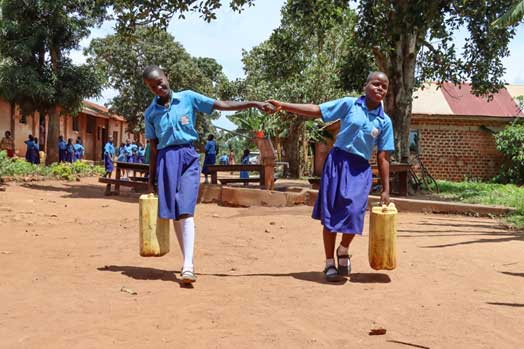On December 19, 2011, the UN General Assembly adopted Resolution 66/170 declaring October 11 as the International Day of the Girl Child.
– This year commemorates the 10th anniversary of the International Day of the Girl Child. While the last decade has seen greater attention on the positive development needs of girls, we must move beyond documenting the barriers that girls face to investing in and prioritizing girl-centered solutions to the critical development challenges of our world.
In light of the triple planetary crisis of climate change, air pollution and biodiversity highlighted in UN Common Agenda consultations in August, the vital role adolescent girls can play in climate-responsive solutions should not be underestimated.
Adolescent girls are among the most vulnerable to climate stress, natural disasters, and environmental degradation. With women, they are an estimated 80% of those displaced by climate-related disaster and represent 60% of the global population facing chronic hunger due to food insecurity.
Recent UNFPA studies have established the links between climate change, reduced and lost access to resources, and the pressures that result on households to survive. Families affected by climate change often have limited resources to begin with and even less after an acute weather-related disaster.
For those dependent on the environment for nutrition, health and household resources, this pressure results in early marriage or trafficking of girls for the sake of generating a source of income and/or reducing a household burden.
When climate change exacerbates existing inequities or the exclusion of girls – including their protection and access to functional, soft, life and technical skills development – household, community, and national level health and education outcomes are negatively affected; sometimes even for generations.
But what if we could change this harmful dynamic? What if we could effectively link the resilience, optimism, and resourcefulness of adolescent girls to new ways of investing in climate-related mitigation strategies?

Credit: UNICEF
What if we could turn existing environmental threats into “tipping-point” opportunities for better approaches to and investments in adolescent girls’ social and economic development?
With the most to lose from the harmful effects of climate change, girls and women also have the most to gain from climate-friendly development strategies that allow them to be active participants in and key contributors to community-led responses.
Adolescent girls can be the strongest catalysts for behavior and systems change if we understand their existing assets, the spaces they occupy, and the influence – invisible or otherwise – they have within households and communities.
Findings from an econometric study spanning four decades from the 1960s to early 2000s showed that adolescent girls’ rates of enrollment and retention in school significantly reduced weather-related death, injury and displacement at community level.
This is because with every year of education or skills training, adolescent girls’ self-confidence, leadership, communication, life and livelihoods skills increased.
As these more educated and skilled girls enter adulthood, they have greater decision-making power and create demonstrably healthier, safer, and more productive households.
There is a clear opportunity to connect the dots for those who occupy and are best placed to protect the land and its resources, as well as reinforce the health and safety of their households. In rural areas, especially, adolescent girls will become the next generation’s agricultural labor force.
If women worldwide are 40% of the agricultural labor force and responsible for more than half the world’s food production, and if education and skills training are prioritized for them, households will move beyond subsistence level farming to engage more as micro-businesses supporting farm-to-table supply and value chains.
This strengthens women-led engagement in diversifying agricultural approaches, through aquaculture and apiculture, and the connection of these innovations to economic development, as well as better health and nutrition outcomes.
To this end, climate-adaptive food systems can have a virtuous relationship, sustaining local suppliers and reinforcing local food security, and effectively weather-proofing communities by ensuring that everyone – in particular women and girls – has access to the knowledge and skills to save lives and sustain livelihoods.
We can take steps to harness the strength and resilience of adolescent girls everywhere even as we act urgently to mitigate the deleterious effects of climate-risk.
First, we must invest more in secondary education where the highest rates of dropout for girls occurs between lower and upper secondary level. This investment should include building context-relevant climate-smart skills for the resilience of households and communities.
Second, we must support the start-up of environmentally-friendly and climate-adaptive small businesses as part of workforce development and smart-financing strategies inclusive of adolescent girls and young women, especially in rural areas where green jobs can strengthen rural to urban supply chains and overall food security.
And finally, we must build community development plans that include ways young people, in particular adolescent girls, can support conservation and climate-risk reduction efforts as part of civic engagement – which will continue to reduce death, injury and displacement.
Without these forward-thinking investments in adolescent girls as key stakeholders in community development, harmful social and cultural attitudes that pit a woman’s role as a mother or wife against learning and livelihoods (and dismiss her right to own land) will continue, continuing a trend of lost opportunity on the grandest of scales.
Amy West of Education Development Center and Sharon Iwachu, Global G.L.O.W., Girl Advocacy Committee Alumni with Art of a Child in Uganda. EDC and Global G.L.O.W. are active members in the Coalition for Adolescent Girls (CAG), a member-led and driven organization dedicated to supporting, investing in, and improving the lives of adolescent girls.
IPS UN Bureau
Source:/www.ipsnews.net


